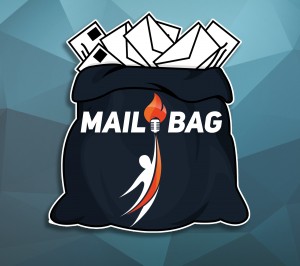S2: Mailbag! #52

Mailbag for May 19, 2016
Time for the Mailbag!
Romy answers three great listener questions followed by a light-hearted full song by Tim Schumack of Detroit.
Full Transcript
Thanks for tuning into our mailbag episode. This is Romy and I will answer three of our listener questions. Let’s get right to it…
Question #1
From: Melissa
Question: How do you pick your guests?
Answer: Our guest selection is somewhat process and somewhat random!
We are looking for primarily for guests that are social entrepreneurs but we also like to talk to those that are connected in some way.
If they are a social entrepreneur, we then look for a couple of things such as:
1- Do they have an enterprise going (selling some type of product or service) or plan to do so in the near future?
2- Is their social mission focused?
3- Are they willing to talk about what challenges they are or have faced (along with the good stuff). We are trying to have real issues and stories discussed so we can all learn together and inspire
4- Do they have a way to be reached by our listeners/willing ..
5- Would they enjoy some free PR
For support systems such as investors, funders, consultants, etc., we are developing niche monthly segments, etc.
Question #2
From: Matt B.
Question: Where do I put my environmental cost savings on my profit and loss statement? We know, from our community reports, that our organization helps to save our community $350,000 last year.
Answer: Yes, this one comes up a lot. So, the short answer is ‘ you don’t put environmental cost savings in dollars on your profit and loss. Two parts to this answer: one has to do with cash accounting and the other has to do with environmental social enterprises (or, what some people refer to as triple bottom line businesses). It all has to do with what runs through your bank account and what does not.
Part one: Your profit and loss is, essentially, a report of all of the cash that came in from sales of products and services and a list of the cash expenses that went back out of your bank account. The bottom of the profit and loss shows you if you had some left over – or not- at the end of that period. So, the first part of this answer is to anchor on the fact that your bookkeeping, accounting, and financial reporting are tracking monies coming in and out. For the purposes of this answer, we are not going to pay attention to money that you owe or are owed. Just assume we are tracking cash.
This brings me to part two of this answer: In general, when you operate a social enterprise that is having a positive effect on the environment, that effect is usually in the form of savings. Your organization is probably reducing a cost somewhere either internally, in your community, or for the broader globe. For example, by using a certain type of packaging for your retail products, you may be reducing the amount of trash in landfills and other toxic ramifications. You may even be saving money locally, such as our friend with this question. Now, this environmental savings effect is real and, most likely, has a dollar value.
Here is where the confusion comes in: even though the dollar savings are real, you will not be recording it in your organizations expenses or revenue or on any of the traditional financial statements. Why? Because traditional financial statements are tracking cash coming in and out of your bank account. The environmental saving dollars are not coming in or out of your bank account.
Now, there is a great place to record your environmental savings and reductions and that is on your social impact reporting! This is the one and only place to record them.
As a matter of fact, anytime you are reducing a cost to a government, a local agency, another non-profit, person, or community, you will record those savings in a social impact report.
So, let’s summarize, you don’t record environmental savings on your profit and loss because that is a financial statement recording your sales and expenses that are or will be moving through your bank account. The easiest way to think about it is if it is running through your bank account or not.
Let me catch one more item. There are such things as Double Bottom Line reports which are a version of a profit and loss that are extracting out the hard dollar expenses associated with the social impact instead of lumping it all together. Again, it is ultimately tracking the bank account activity.
Question #3
From: Anonymous
Question: How come you don’t have a Mystery Sound on every episode?
Romy – Thank you, anonymous, for that question. You are right. We don’t have a mystery sound on each episode. That is because some of the social entrepreneurs don’t have their own place of business or maybe they aren’t producing something that would even make a sound. For example, they might be a financial firm – not much to capture there.
When our team was thinking about the Mystery Sound, we were brainstorming about fun things to add to the show. We didn’t really think about the fact that we might not be able to capture a sound every time. Ha ha. Oh, the lessons of entrepreneurship. Ha ha But! We are not moving away from the Mystery Sound, we are just going to capture it when we can. So, I guess, the Mystery sound…will be a mystery!
Well, that’s all for now from the mailbag.
To submit a question to the mailbag, please go to bonfiresofsocialenteprise.com and click on the home page box that says ‘ Submit to the Mailbag’
We love your questions and promise to answer every one of them. And, if you give us permission, we will read yours on the air.
Thanks for tuning in to our mailbag episode.
As we close out we want to leave you with another great Detroit artist curated by Assemble Sound. Please meet Tim Schumack and his song ‘You’ from his Album ‘I See Clear Skies’
End of Transcript
MORE
Jump over to the website for the podcast at www.bonfiresofsocialenterprise.com
Guess the mystery sound for the upcoming episode in the link on that site or give us a question to the mailbag!
Find us on Facebook and Twitter @bonfirespodcast
Our Blog and Content gingrasglobal.squarespace.com
Find more about Gingras Global at www.gingrasglobal.com and www.gingrasglobalgroups.com and Facebook of Gingras Global and Twitter @gingrasglobal

